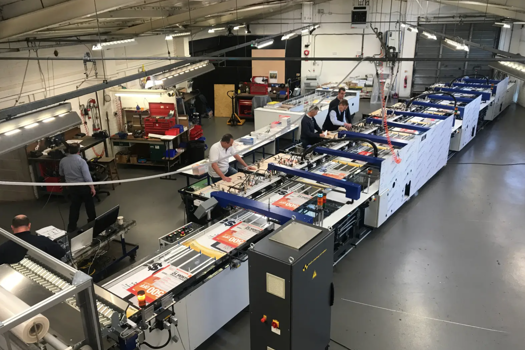While Romano, whose career spans 50 years in the printing and publishing industries, and who is currently professor emeritus at the Rochester Institute of Technology (RIT) in New York, was positive about the future of print, he warned that printers would need to explore new markets as print volumes continue to decline.
"In the past, commercial printers only had to compete with other commercial printers, but that is no longer the case. Now you have to compete with suppliers from outside of your niche," he said.
Romano, who highlighted trends from around the world and their impact on the print sector, noted that many commercial printers had begun to diversify into packaging, but warned that packaging could suffer the same drop in margins as commercial print.
He said: "In packaging, we are starting to see price competition similar to what we have seen in other markets. If the trend continues, we will see the commoditisation of packaging because printers just want to keep their presses running. They don’t want to lay people off."
Other challenges facing those in the packaging sector are the continued offshoring of manufacturing, said Romano, but he added that inflation in China is making it less attractive and causing many companies to set up elsewhere.
"We are seeing shifts away from manufacturing in China where labour rates are going up," he said.
Rather than bring work back to the West, however, manufacturers are looking for cheaper labour in other countries, he noted.
"We are seeing some printing shift to Vietnam where the industry is growing," he said.
Romano suggested that the need for newspaper printers to diversify into other sectors is increasingly urgent. Echoing comments made by Rupert Murdoch, who warned in April that printed newspapers will cease to exist in 20 years, Romano highlighted the willingness of older generations, who have typically been characterised as technology-averse, to embrace devices such as iPads and Kindles.
"This, along with the immediacy of online news, makes me believe that printed newspapers are not long for this world," he said.
"If newspapers survive, there will probably be very few of them and they will have to provide something other than news."
He said that he was seeing a growing trend whereby newspaper printers were competing for work with commercial printers.
"At the printer that produces the New York Times, three-quarters of the work done on their presses is commercial work," he added.
Romano expressed doubt over the market for on-demand newspapers and said that he did not expect print on-demand to change the newspaper sector in the same way that it has impacted books.
Brighter future
He predicted a brighter future for magazines, adding that the catalogue market is "robust" and" doing well".
Romano also recommended that printers explore other, less conventional growth areas, such as textile printing and security printing, rather than focusing purely on more traditional sectors.
"Printers need to discover new markets in areas that they may not have considered before, such as textile printing or hologram printing using traditional presses that have been slightly modified. We are already seeing some printers looking for these new marketplaces," he said.
Another potential opportunity highlighted by Romano was the shift in the breakdown of printer revenues, with a larger proportion often coming from non-print services.
"More printers are offering additional services such as fulfilment and direct mail, which can generate more revenue than the actual printing of the piece," he said.
Romano also highlighted that some of the finishing equipment shown at Drupa could create opportunities by enabling printers to diversify by adding value to their work.
"We saw devices such as an embossing machine demonstrated by Scodix which gives you texture on the material. Printers can differentiate themselves with the finishing of their work," he said.
The tendency of print buyers to focus only on price was another issue noted by Romano, who told of an association in the US called Print Buyers International, which aims to educate people in the sector about different printing techniques, and how to successfully bring print into the marketing mix.
Romano concluded his presentation with a similar message to the one with which he opened: he emphasised that, while print volumes will continue to decline, there will be winners and losers.
"Printers who can offer something different and who can add value, whether through additional services or through finishing applications such as foiling, embossing or stamping – the businesses that do this will be among the winners," he said.
30-SECOND BRIEFING: ROMANO'S WORDS OF WISDOM
- Printers need to explore new markets, including less traditional sectors such as textile and industrial printing
- Many commercial printers are moving into packaging and price competition is starting to appear
- The trend for printers to diversify into packaging could lead to the commoditisation of the sector
- Inflation in China means that companies are starting to set up factories in different countries such as Vietnam, which has a growing print sector
- Older generations are embracing new technology, such as iPads and Kindles, which could contribute to the Newspaper printers and commercial printers are now in competition for commercial print jobs
At the New York Times, 75% of the work produced on the presses is commercial print - Printer revenues are coming from changing sources, with some printers making more money from services such as fulfilment than from printing
READER REACTION
What did Frank Romano’s post-Drupa speech mean to you? Mark Lawn
Mark Lawn
European and UK marketing director, Canon
"As Frank said, print is changing constantly and we have to ensure the publishers, vendors, service providers are all adapting to the changes. At Drupa, we saw much more interest in the services around print, and what applications and workflows (and ultimately what sales and marketing approaches) would be successful. We also saw the entrepreneurial spirit come out at Drupa. It was about the capability you can deliver, the services and the knowledge. As a result, we are finding new markets and opportunities." Kathy Woodward
Kathy Woodward
chief executive, BPIF
"It’s interesting to hear someone independent give an overview of everything that was presented at Drupa and a summary of global industry trends. Frank’s warning about turning packaging into a commodity market was very interesting; printers who are venturing into packaging obviously need to think about how they can make it work for them. It’s good advice for commercial printers to look at their position in the market and explore future growth. Obviously, it all goes back to ROI and whether you will be responding to a particular customer’s needs."
 Julian Long
Julian Long
National key accounts manager, Arjowiggins
"We didn’t go to Drupa this year, as it is difficult to justify as a paper company. However, listening to a leader in the industry highlight the trends and technology coming from the press manufacturers helps us to keep ahead of the game. Our principal commitment is to environmentally friendly paper first and foremost, but of course we also need to adapt to the upcoming presses and techniques on the market so it was good to hear Frank’s overview and research along with other opinions from the industry."










